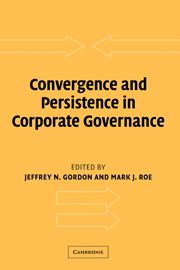Book contents
- Frontmatter
- Contents
- List of figures
- List of tables
- List of contributors
- Acknowledgments
- Introduction
- PART I Systemic issues
- 1 The end of history for corporate law
- 2 A theory of path dependence in corporate ownership and governance
- 3 Path dependence and complementarity in corporate governance
- 4 Globalizing corporate governance: convergence of form or function
- PART II Government players
- PART III Specific institutions
- Index
- References
3 - Path dependence and complementarity in corporate governance
Published online by Cambridge University Press: 04 March 2010
- Frontmatter
- Contents
- List of figures
- List of tables
- List of contributors
- Acknowledgments
- Introduction
- PART I Systemic issues
- 1 The end of history for corporate law
- 2 A theory of path dependence in corporate ownership and governance
- 3 Path dependence and complementarity in corporate governance
- 4 Globalizing corporate governance: convergence of form or function
- PART II Government players
- PART III Specific institutions
- Index
- References
Summary
Introduction
Our goal is to use the concept of path dependence as developed by Bebchuk & Roe in their chapter, “A theory of path dependence in corporate ownership and governance,”. as a springboard for discussion of how the necessary addition of institutional “complementarity” further complicates the case for corporate governance convergence. We conclude with an example that shows how the efforts to attain convergence can produce a corporate governance regime inferior to that which it has replaced.
The substantial theoretical contribution of Bebchuk and Roe consists in their integration of four concepts: path dependence; efficiency; evolution; and convergence. In doing so, they take a considerable step beyond what Mark Roe's stimulating earlier works contained on path dependence. In his 1994 book Strong Managers, Weak Owners, Roe had demonstrated that many institutional features observed today were shaped by idiosyncratic historical events which in hindsight seem to have been accidental in nature. The general lesson of his research is that history and politics matter, and certainly matter more than the conventional wisdom in economics and the law and economics community in America suggests. Combined with efficiency and evolution, the concept of path dependence creates a solid theoretical basis for the empirical accounts provided in Roe's book.
At the substantive level, Bebchuk and Roe derive crucial implications by applying these concepts to fundamental questions in the area of corporate governance, and they challenge the predominant view among economists as well as law and economics scholars that the corporate governance systems in the major industrial countries are likely to converge at a rapid pace.
- Type
- Chapter
- Information
- Convergence and Persistence in Corporate Governance , pp. 114 - 127Publisher: Cambridge University PressPrint publication year: 2004
References
- 28
- Cited by

